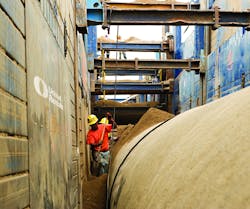How to Build a Safety Culture in Trench and Excavation Projects
Electric transmission and distribution systems deliver power to communities, businesses and consumers across millions of miles of lines through a mix of overhead and underground infrastructure.
The trench and excavation work required to support underground electrical infrastructure projects can be a dangerous undertaking. The work often takes place in congested areas and on public roads and building sites. A cubic yard of soil weighs as much as a car, so a trench collapse can kill in minutes. According to the Bureau of Labor Statistics, excavation and trench-related fatalities in 2016 were nearly double the average of the previous five years.
Complying with OSHA’s trench safety standards and maintaining constant awareness of the hazards associated with trench work can prevent deaths and injuries. Safety improvements can also lead to other job-site gains with companies experiencing significant benefits from their safety investments. These benefits include positive impacts on budget, schedule and quality. Establishing a safety culture not only keeps employees safe; it also leads to improved project productivity.
Here are six steps every utility and contractor need to take to create a safety culture for their trench and excavation work in underground electrical infrastructure projects:
1. Follow OSHA Standards. OSHA specifies safety standards for protecting workers from cave-ins, which the agency cites as presenting the greatest risk. Cave-ins are much more likely to result in worker fatalities than are other excavation-related accidents. Because trench construction involves multi-layered situations, these standards address requirements for sloping, benching, shielding and shoring, in addition to soils analysis and guidelines for installing and removing protective systems. Employees – at every level – should learn these standards and review them regularly.
2. Create a Written Policy. Companies need comprehensive policies that detail safe trench and excavation practices. The policy process should accommodate suitable planning and supervision, compel recurrent inspections of excavation sites to detect any change in soil conditions and confirm adequate support for trenches. A sound policy will systematically detail responsibilities and standardize safe practices for employees.
3. Commit to Training. A more educated workforce is a safer and more productive workforce. The challenges of job site safety and productivity are something companies face every day. Lectures with minimal classroom engagement are not enough. Companies need to look to dedicated resources that offer quality safety training along with support outside the classroom – including job site consultation, engineered designs and safety equipment.
Consider participating in the annual Trench Safety Stand Down, which takes place June 17-21 this year. The Trench Safety Stand Down is a valuable resource and an excellent opportunity to discuss safety with workers, including the hazards of working in and around trenches and excavations.
4. Assign a Competent Person. The competent person is the one person most responsible for employee safety. Compliance with OSHA standards requires the designation of a competent person to inspect trenches and identify potential hazards. Inspections must cover every aspect of excavation, safety and shoring equipment, and address soil type, work in adjacent areas, the possibility of vibrations and weather conditions.
As part of the pre-work hazard inspection, the competent person confirms that workers have proper protective equipment. Additionally, according to OSHA, competency means the individual can identify existing and predictable hazards or working conditions that are hazardous, unsanitary or dangerous to employees. The competent person has authorization to take prompt corrective measures to eliminate or control these hazards and conditions.
5. Have the Right Protective Solution. Protective equipment to improve productivity and worker safety has become significantly better with advancements in both manufactured systems using tabulated data and site-specific engineered solutions using shields, shoring, bracing and high-arch clearance spreaders. Lighter-duty shields with high-arch clearance, cut-outs and guide frames, and larger-capacity hydraulic bracing, give contractors more options to manage the quality, production and safety of their projects. It’s vital for companies, which work in underground operations, to consider every safety resource available to workers – including analysis on protective system solutions, on-site consultation and engineering designs.
6. Build a Safety Culture. The ultimate trench protection goals for utilities and contractors are ensuring safety and productivity. To achieve these goals, they need an OSHA-compliant and comprehensive trench protection system, along with an effective training program that is adopted by employees at every level. Companies should also look for partnerships to assist when safety decisions are beyond a company’s typical scope of performance or experience. With the right programs in place, organizations can create a safety culture that not only provides safe job sites but also enables workers to be productive in delivering quality results on schedule and budget.
Note: This article is for informational purposes only and generally discusses common industry processes and procedures. This article is not intended to be a substitute for site-specific professional/expert advice, instruction and supervision. United Rentals recommends consulting with Shoring and Excavation Experts to ensure full compliance with Federal OSHA 29 CFR, Part 1926, Subpart P-Excavations and Trenches, and any other applicable rules and regulations.
About the Author
Blake Smith
sales and marketing director
Blake Smith is a sales and marketing director at United Rentals and a former region product development manager for trench safety.
